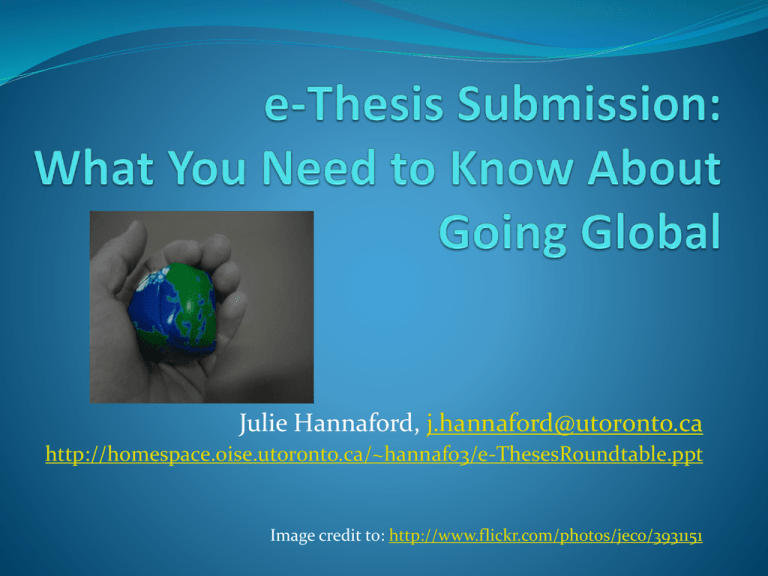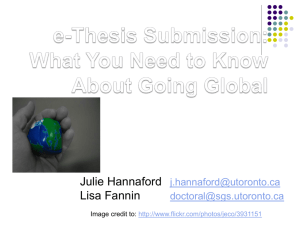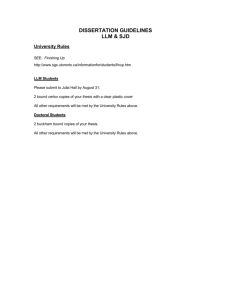T-Space: What You Need to Know About Electronic Submission
advertisement

Julie Hannaford, j.hannaford@utoronto.ca http://homespace.oise.utoronto.ca/~hannafo3/e-ThesesRoundtable.ppt Image credit to: http://www.flickr.com/photos/jeco/3931151 General Overview of Changes Thesis and dissertation submission must now be made electronically Upload is done via T-Space Upload will be publicly available after convocation OISE Library no longer requires 2 bound copies A processing fee continues – this fee is to produce the microfiche version of your thesis and other administrative costs SGS website Electronic submission overview What is T-Space? University of Toronto’s research repository OISE’s T-Space Community Intended to showcase and preserve scholarly works Support for multiple file formats – now you can upload video/audio/data sets that support your thesis Provides permanent URLs – no more broken links! Searchable via Google or other search engines (with priority ranking) Result: more opportunities for your work to be found, read, and cited First Steps T-Space requires that your thesis or dissertation be in PDF format Use Adobe Acrobat Writer or Acrobat Professional software/MS Word 2007 There is support in the EC if needed If you have accompanying material, make sure that it is also available electronically – scan images, prepare audio or video files, etc. EC Media Service can provide help with audio/video Image credit: http://www.flickr.com/photos/stjernesol/2726886107 Next Steps There are naming conventions that you must follow: Thesis: Supplementary files: Image credit to: http://www.flickr.com/photos/atoach/3978319410 Next Steps Obtain all necessary copyright permissions SGS provides a sample permissions letter Ensure that your thesis is formatted correctly OISE Guidelines Submit to SGS: Written confirmation from your supervisor that your thesis has been approved in its final form All copyright permissions you have obtained Signed and dated Library and Archive Canada Theses Non-Exclusive License Proof of payment of your submission fee If necessary, a Restricted Release Form Image credit to: http://www.flickr.com/photos/atoach/3978319410 Additional Info: Copyright You need copyright permission if you are using someone else's work, your own previously published material, or work you have co-authored with another; this includes large direct quotes, tables, figures, images, etc. # of words can vary. OISE guidelines note: 20-25 lines of text (approx. 200 words) Obtain permission from the copyright holder (who may not be the author) Once you have permission, you must cite the work appropriately Additional Info: Copyright You may be able to locate publishers’ policies re: copyright/permissioning here: SHERPA/RoMEO Additional links: Canadian Intellectual Property Office FAQs Canada’s Copyright Act U of T’s Copyright Policy Copyright FAQ for Instructors Ready to Upload! Create an account on T-Space here SGS will be notified via email and will approve your account Once approved, you will be sent an email to let you know that you can login Once you are logged in, click on “Start a New Submission” Image credit to: http://www.flickr.com/photos/zhurnaly/196310475/ Describing Your Content Fill in the fields to describe your thesis or dissertation Important: Enter your name as it appears in ROSI Describing Your Content, cont’d To choose a subject code, use this site: UMI Subject Categories Be as descriptive as possible: the more keywords you use the more your work can be found by end users when searching via Google, etc. Select a CC License (Optional) Grant T-Space License Now What? SGS will review your submission and let you know when it has been approved Once you have attended convocation, your thesis will be made public Search the collections: Masters theses: https://tspace.library.utoronto.ca/handle/1807/9947 Doctoral dissertations: https://tspace.library.utoronto.ca/handle/1807/9945 Image credit to: http://www.flickr.com/photos/carbonnyc/143186839 For the Future… Be aware of copyright issues when you are seeking publication Did you know that when you seek publication, the copyright release form often signs the rights to your work over to the publisher? When working with publishers, you can negotiate your copyright so that you have the right to self-archive or otherwise distribute your work; see the SPARC Author Addendum Protecting your rights as an author allows you greater flexibility with forthcoming publications Open Access “Open-access (OA) literature is digital, online, free of charge, and free of most copyright and licensing restrictions” (http://www.earlham.edu/~peters/fos/overview.htm) Open access increases the availability of your academic work to the research community Prioritized indexing of T-Space content by Google and other search engines improves visibility and citation impact – more people will read your work Granting Councils are increasingly mandating wide dissemination of funded research outputs. CIHR and ERIC now require institutional open access archiving of publications; SSHRC supports open access in principle. Image credit to: http://www.flickr.com/photos/wakingtiger/3157622608/ Interested in Learning More? Check out some open access links here: http://delicious.com/OISEOpenAccess Open Access Scholarly Information Sourcebook (OASIS): http://www.openoasis.org/ Listen to John Willinsky’s recent talk at OISE on open access issues






